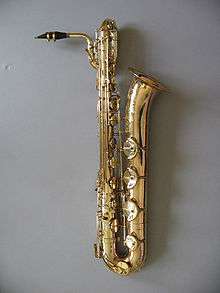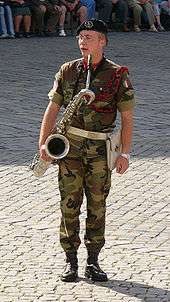Baritone saxophone
 | |
| Woodwind instrument | |
|---|---|
| Classification | |
| Hornbostel–Sachs classification |
422.212-71 (Single-reeded aerophone with keys) |
| Inventor(s) | Adolphe Sax |
| Developed | 28 June 1846[1] |
| Playing range | |

| |
| Related instruments | |
|
Military band family:
Orchestral family: Other saxophones:
| |
| Musicians | |
| More articles | |
The baritone saxophone or "bari sax" (commonly abbreviated bs or bars to distinguish it from the less frequently used bass saxophone) is one of the largest members of the saxophone family, only being smaller than the bass, contrabass and subcontrabass saxophones. It is the lowest-pitched saxophone in common use, and uses a mouthpiece, reed, and ligature that are larger than the tenor, alto and soprano saxophones, the other commonly found members of the family.[2] The baritone saxophone is commonly used in classical music (such as concert bands, chamber music and solo repertoire), military bands, marching bands and jazz (such as big bands, jazz combos, etc.).
History
The baritone saxophone was created in 1846 by the Belgian instrument maker Adolphe Sax as one of a family of 14 instruments. The saxophone was created to be a tonal link between the woodwinds and brasses, which Sax believed to be lacking. The family was divided into two groups of seven saxophones each from the soprano to the contrabass. The family consisting of saxophones ranged in the keys of B♭ and E♭ were more successful because of their popularity in military bands. The bari sax, pitched in E♭, is the fifth member of this family.[3]
Description
The baritone saxophone, like other saxophones, is a conical tube of thin brass. It has a wider end, flared to form a bell, and a smaller end connected to a mouthpiece. The baritone saxophone uses a single reed mouthpiece like that of a clarinet. There is a loop in the neck to reduce it to a practical height, colloquially referred to as a “Q”.
Baritone saxophones come in two sizes with one ranging to low A and the other to low B♭.[4] Originally, all baritone saxophones were low B♭ instruments, but over time players began modifying their horns to reach the low A below. In the 1980s, it became common for saxophone manufacturers to produce low A instruments. In modern times, the low A is considered standard and is often written in sheet music for the instrument. Despite the ubiquity of the low A horn, some players still prefer to use B♭ horns because of the added weight and supposedly poorer tone quality of low A horns.[5] As is true for other saxophones, the F♯ key was also a later addition to the horn now considered standard.
The baritone saxophone’s relatively large mass (15 to 35 pounds or 6.8 to 15.9 kilograms depending in large part on the horn’s age) has led to the development of harness-style neckstrap that distributes the instrument's weight across the user's shoulders.[6] Several different kinds exist, produced by brands as well known as Neotech and Vandoren, and each distributes weight differently across the saxophonist’s neck, clavicle, and shoulder blades. Many marching saxophonists prefer this style for its ability to decrease fatigue. Those who mainly perform seated, on the other hand, may dislike the decreased ability to move one’s upper body.[6]
Technical specifications
It is a transposing instrument in the key of E♭, pitched an octave plus a major sixth lower than written. It is one octave lower than the alto saxophone. Modern baritones with a low A key and high F♯ key have a range from C2 to A4. Adolphe Sax also produced a baritone saxophone in F intended for orchestral use, but these fell into disuse. As with all saxophones, its music is written in treble clef.
In classical music
The baritone saxophone is used as a standard member of concert bands and saxophone quartets.
It has also been occasionally called for in music for orchestra. Examples include Richard Strauss' Sinfonia Domestica, which calls for a baritone saxophone in F; Béla Bartók's The Wooden Prince ballet music; Charles Ives' Symphony No. 4, composed in 1910-16; and Gershwin's Rhapsody in Blue and An American in Paris. In his opera The Devils of Loudun (Die Teufel von Loudun), Krzysztof Penderecki calls for two baritone saxes. Karlheinz Stockhausen includes a baritone in Gruppen.
It has a comparatively small solo repertoire although an increasing number of concertos have appeared, one of these being "Concerto for Saxophone Quartet and Orchestra" by American composer Philip Glass. This is a piece that can be played with or without an orchestra that features the baritone sax in the second movement.[7]
In jazz music
A number of jazz performers have used the baritone saxophone as their primary instrument. It is part of standard big band instrumentation (the larger bass saxophone was also occasionally used up until the 1940s). As phrased by Alain Cupper from JazzBariSax.com, "Used a few times in contemporary classical music...it is especially in jazz that this wonderful instrument feels most comfortable."[8] One of the instrument's pioneers was Harry Carney, longtime baritone player in the Duke Ellington band.
Since the mid-1950s, baritone saxophone soloists such as Gerry Mulligan, Cecil Payne, and Pepper Adams achieved fame, while Serge Chaloff was the first baritone player to achieve fame as a bebop soloist. In free jazz, Peter Brötzmann is notable.
More recent notable performers include Hamiet Bluiett (who has also led a group of baritone players), John Surman, Scott Robinson, James Carter, Stephen "Doc" Kupka of the band Tower of Power, Nick Brignola, Denis DiBlasio, Gary Smulyan, Brian Landrus, Ronnie Cuber, and Frank Basile. In the avant-garde scene, Tim Berne has doubled on bari. A noted Scottish performer is Joe Temperley, who has appeared with Humphrey Lyttelton as well as with the Lincoln Center Jazz Orchestra.
In other music

The baritone sax is an important part of military bands and is common in musical theater. The baritone sax also plays a notable role in many Motown hits of the 60s, and is often in the horn sections of funk, blues, Latin and soul bands. It is sometimes also used in rock music.[9]
Prominent baritone saxophonists in contemporary American popular music include Stephen Kupka of Tower of Power and Dana Colley of Morphine
Nigerian Afrobeat singer, musician, and bandleader Fela Kuti typically featured two baritone saxophone players in his band.
A few modern non-jazz artists have recently begun to incorporate saxophones into their instrumentation. The LA Indie rock band Fitz and the Tantrums featured both an alto and a baritone saxophone in their music—most recently their 2016 song "Handclap" from an album of the same name. Both were played by band member James King.[10][11] The "Brasshouse" (experimental jazz/funk) group Too Many Zooz is another group that has popularized the baritone horn. Originally a New York City subway band, the trio has released three albums and been featured on a TEDx Budapest segment.[12][13]
In popular culture
TV Shows
In The Simpsons, Lisa Simpson plays a baritone saxophone. The artist who typically performs her solos is Terry Harrington.[14]
References
- ↑ "June 28, 1846: Parisian Inventor Patents Saxophone". Wired.com. Retrieved 14 February 2011.
- ↑ Charles, Roger. "The History of the Saxophone". Retrieved 5 October 2013.
- ↑ Harrelson, Brad. "The History of the saxophone". Retrieved 5 October 2013.
- ↑ Charles, Roger. "The baritone saxophone, past and present.". Retrieved 5 October 2013.
- ↑ Hadro, Andrew (November 18, 2014). "Brands and Horns". JazzBariSax.com. Retrieved April 17, 2016.
- 1 2 Schwietert, Adam (September 28, 2012). "Saxophone Neck Strap and Harness Study" (PDF). Research. Coordinate Movement. Retrieved April 17, 2016.
- ↑ Schwarm, Betsy. "Concerto for Saxophone Quartet and Orchestra". Encyclopedia Britannica Inc. Retrieved 5 October 2013.
- ↑ Cupper, Alain. "About the Bari Sax". JazzBariSax.com. Retrieved April 17, 2016.
- ↑ "Saxophone". The New World Encyclopedia. August 21, 2015. Retrieved April 17, 2016.
- ↑ Ellen Degeneres, Fitz and the Tantrums (April 12, 2016). Fitz and The Tantrums Perform 'HandClap' (Video (Online)). Burbank, California: TheEllenShow.
- ↑ "James King". Artist Info. D'Addario Woodwinds. Retrieved April 17, 2016.
- ↑ "Eugene: Cozmic Presents TOO MANY ZOOZ". BestEvents. December 24, 2014. Retrieved April 17, 2016.
- ↑ Zaslow, Alexandra (March 25, 2014). "Subway Performers Energe from the Underground to Become Viral Rockstars". The Huffington Post. Retrieved April 17, 2016.
- ↑ Harrington, Terry (2012). "TERRY HARRINGTON - Lisa Simpson - The Simpsons". Theo Wanne Endorsers. Theo Wanne. Retrieved April 17, 2016.
External links
- Instruments In Depth: The Saxophone—An online feature with video demonstrations from Bloomingdale School of Music (June, 2009)
- Saxophone acoustics from the University of New South Wales
- Great Jazz Baritone Saxophonists and vintage horns—A website with extensive information on popular baritone saxophonists, information regarding the baritone saxophone, and more.